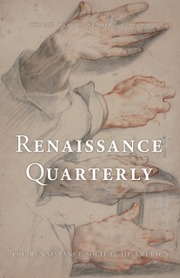Edited by Noémie Ndiaye and Lia Markey, this volume published by ACMRS comes out of both the Newberry Library exhibit and the ongoing RaceB4Race conference series geared toward premodern critical race studies (PCRS). The RaceB4Race conference has also been praised for supporting marginalized premodern scholars in a field that continues to be primarily white and wealthy, and that is currently plagued by crises of identity. The volume attempts to do much of the same by combining exhibition catalogue, field reflections, and methodology using the extensive collection at the Newberry Library in Chicago. The commitment to producing a volume that builds on PCRS while centering the experiences of scholars of color in academia is clear from the work of the editors. This volume serves as a provocative introduction for scholars of the early modern world who want to enter the field, as well as providing reflections and ideas for those currently engaged in this scholarship.
The volume is divided into three main parts: “Figuring,” “Mapping,” and “Performing,” mirroring the Newberry 2023 exhibit. Each section follows a formulaic approach: an essay or two featuring Newberry collection items, an exhibition catalogue of items featured in each section, and reflections in a “notes from the field” section. Contributors to essays come from a variety of fields to model the interdisciplinarity of PCRS. The first “Figuring” essay, by Brandi K. Adams and Carissa M. Harris, discusses the intersections between gender, race, and print culture in its depictions of Black female bodies, highlighting the connections between visual and print culture in mass-produced racialized images. The second essay, by M. Lindsay Kaplan and Dana E. Katz, looks at racialization in forms of costume, fashion, and travel by focusing on Nicholas de Nicolay’s Navigations and his depiction of Jews. Then, librarian Analú Maria Lopez shares her notes on working within a primarily white institution (the Newberry) and her community outreach to the Indigenous communities that such institutions had previously dehumanized.
“Mapping” starts with an essay on the Constantinople/Istanbul split by Roland Betancourt and Ambereen Dadabhoy. Then, Ricardo Padrón and Risa Puleo look at how mapping created, reinforced, and cemented political, legal, and racial ideologies that justified and aided colonization. This section also includes notes from the field by Andrea Myers Achi from the Metropolitan Museum. “Mapping” is perhaps the most satisfying section of the volume, in that it reaches backwards into the Middle Ages and connects it with the premodern and modern worlds, as well as explaining the processes of early colonization.
The final section, “Figuring,” features an essay by Elena FitzPatrick Sifford and Cécile Fromont on gestures, movement, and race as it figured between Africa and its translations and conceptions by European slavers. Fara Karim-Cooper of Shakespeare’s Globe contributed her notes on her diversification of Shakespeare’s Globe and her efforts on making it a place where performers of color can feel heard. The return to Shakespeare leads comfortably to the end, with an afterword in the form of an interview between Kim Hall, Scott Manning Stevens, and L. Lehua Yim. Ending the volume with an interview is both an ideological call for collaboration and a demonstration of the importance of conversation that is advocated by PCRS and critical Indigenous studies. The conversations around the intersections and collaborations between PCRS and critical Indigenous studies offers new directions for such work.
One of the key takeaways from this volume is that it demonstrates how scholars are using and thinking about PCRS, critical Indigenous studies (CIS), and other critical works when engaging with objects of the past to expose an ideological framework of racial hierarchy. Turning the limitation of the Newberry’s collection into one of its strengths, this volume shows that race-making is found in the everyday objects of North American collections while revealing the complicity of institutions with these collections. Contributors to the volume paint a field that is both emergent and established, depending on disciplinary boundaries and training. Another strength is the book’s interdisciplinary integration. Essays range from methodological to reflective without any strong disciplinary lean. Each contributor also proposes a solution—or at least a first step—in addressing the problems they highlight. Points are made to emphasize social sciences and humanities in both their strengths and weaknesses when encountering PCRS, especially in the fields of history and anthropology (217–28).
One of the main limitations comes out of the Western European (and North American) racial praxis from which this volume emerges. Although the collection does a commendable job with integrating European worldviews with the Atlantic and Middle Eastern world, the Indian Ocean and its interconnected Pacific spheres are less discussed, despite the contribution of L. Lehua Yim. Engaging with new race theories from Pacific-world scholars—such as the concept of Ornamentalism—would help balance the volume, especially in sections about costumes, nudity, and the body. Other minor problems include the choice of definitions; to include an editorial note about these decisions would have made the volume more transparent to the decisions that such an important book went through. Lastly, in terms of editorial notes, while the volume addresses the harms done by the Newberry Library, there is no comment by the directors on how the Newberry will continue its decolonization efforts after this exhibit. The Newberry and the ACMRS are to be commended for this well-thought-out and ambitious volume, and the editors have done a lot of hard work in creating a cohesive, instructive, and reflective piece on PCRS. Nevertheless, it is important to address that commitment to decolonization is ongoing, and if the library continues these efforts to engage critically with their collection and their community, they could become the model for sustainable and critical library and collections stewardship.


